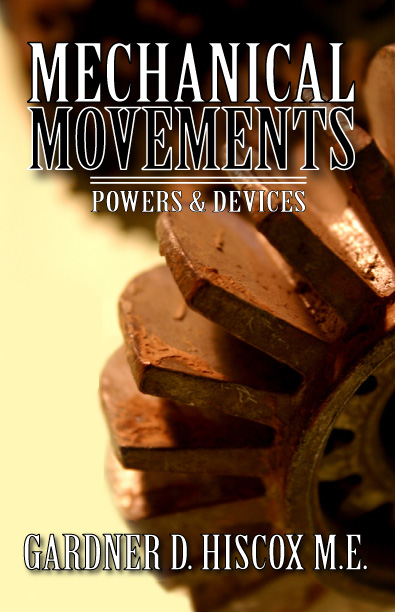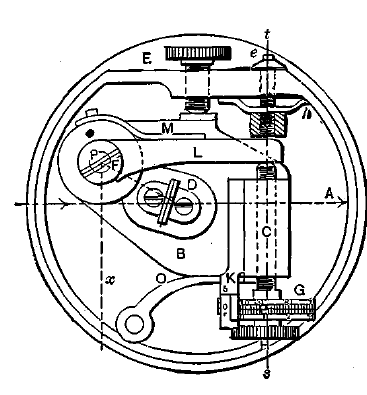MECHANICAL MOVEMENTS POWERS AND DEVICES
MECHANICAL MOVEMENTS POWERS AND DEVICES $19.95
Mechanical Movements is a great work of reference for inventors and experimenters, mechanical students, artisans and any workingman with an inquiring mind and the ambition of an engineer. For anyone with a real interest in mechanical thought and work, this book will fully explain mechanical movements, devices used in constructive and operative machinery and the Mechanical Arts. Mechanical Movements will be your valued mechanical dictionary, commencing with a rudimentary description of the early known mechanical powers and detailing the various motions, appliances and inventions used in the mechanical arts through to present times.
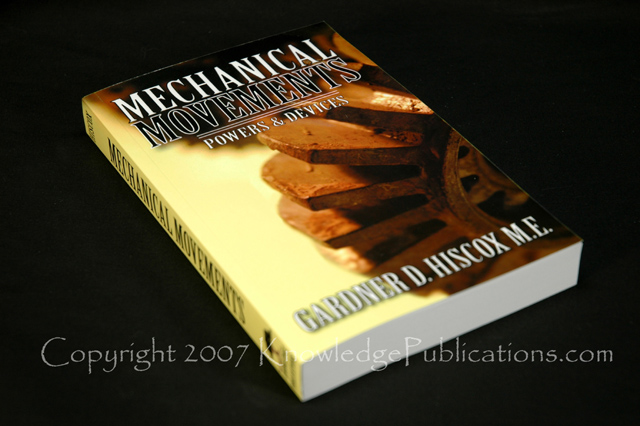
MECHANICAL MOVEMENTS POWERS AND DEVICES
Mechanical Movements explores the borders of inventive design through a review of the ingenuity, creativity and sheer brilliance of engineers and inventors that have artfully overcome obstacles with superior mechanical designs. It clearly and concisely describes and draws out the principles and facts in constructive and operative mechanics. This book contains a huge collection images which illustrate a wide range of mechanical motions, devices, and technologies, and to places them in an excellent format for ready reference.
Mechanical concepts and details are ideally presented to the mind by diagrams or illustrated forms. This book provides a simple and fast method for understanding the exact conditions of mechanical actions and construction. The images are accompanied by sufficient text to explain the general principles of construction and operation, and mechanical forms shown. Mechanical Movements will convey to you, via illustrations and short attached descriptions, the most important principles and facts in constructive art.
This book was specifically designed for quick and easy use. We have republished Mechanical Movements in order to place a huge amount of illustrated practical mechanical knowledge in YOUR hands; all within one phenomenal book.
SECTION 1: THE MECHANICAL POWERS.
WEIGHT, RESOLUTION OF FORCES, PRESSURES, LEVERS, PULLEYS, TACKLE
The Resolution of Suspension—
Lever Paradox—
The Lever and Its Power—
The Inclined Plane—
The Wedge—
The Screw—
Worm Gear or Endless Screw —
Chinese Wheel—
Tackle Blocks—
Chinese Windlass—
Chinese Shaft Derrick—
 |
CHINESE WINDLASS—The sheave and hook rises equal to one-half the difference in the circumference of the barrels for each turn of the crank. See No. 27 for the power.
CHINESE SHAFT DERRICK—The sheaves suspended from the upper part of the derrick legs allows the bucket to be raised above the mouth of the shaft or pit by the differential windlass. |
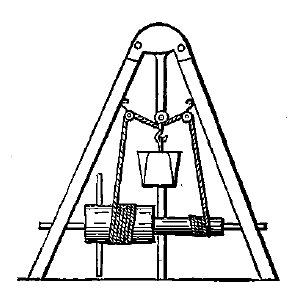 |
Compound Weight Motor—
Rope Twist Lever—
Spanish Windlass—
Rope Grip Hook—
Guy Rope Clip and Thimble—
Rope End—
Hemp Rope End—
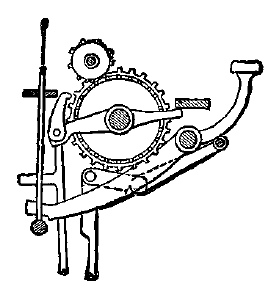 |
LEVER MOVEMENT— Through a single movement of the finger lever, three different movements are made, including the raising of the index number. LEVER ACTION— The long lever and finger stud is linked to a ratchet lever concentric with the type line barrel. One touch of the finger stud for close lines and two touches for open lines. |
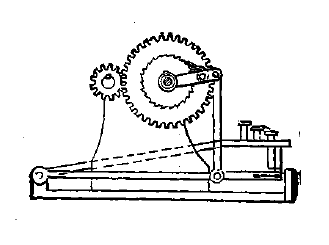 |
SECTION 2:TRANSMISSION OF POWER.
ROPES, BELTS, FRICTION GEAR, SPUR, BEVEL, AND SCREW GEAR
Alternating Circular Motion—
Circular Motion—
Eccentric Crank—
Capstan, or Vertical Windlass—
Steering Gear—
Jumping Motion—
Rope Sprocket Wheel—
V-Grooved Rope Pulley—
Rope Transmission—
Vibratory Motion—
Transmission by Rope—

HORIZONTAL ROPE TRANSMISSION, with tension slide and weight.
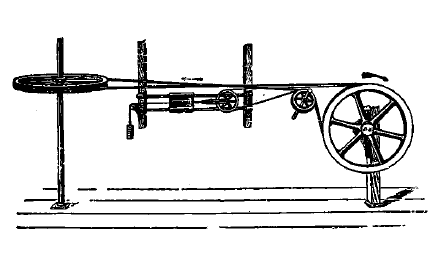 |
ROPE TRANSMISSIONto a movable shaft at right angles from the driving-shaft, with tension slide and weight. |
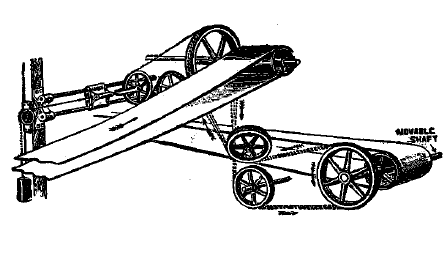 |
Transmission by Rope to a Portable Drill or Swing Saw—
Horizontal Rope Transmission—
Rope Transmission—
Rope Transmission to a Movable Shaft—
Vertical Tension Carriage—
Belt Lacing—
Novel Belt Lacing—
Over‑and-Over Lacing—
Interlocking Belt Lacing—
Cross Lacing—Sectional Belt Lacing—
Quarter Twist Belt—
Full Twist Belt—
Full Twist or Cross Belt—
Belting to a Shaft at any Angle—
Quarter Twist Return Belt—
Change Speed Step Pulleys—
Cone Pulleys—
Curved Cone Pulleys—
Shifting Device for Cone Pulleys—
Belt Transmission—
Belt Transmission of Power—
Variable Transmission of Motion—
Stop, Driving, and Reversing Motion—
Two Speed Pulleys and Belts—
Pulleys, Combined with a Differential Gear—Transmission of Two Speeds—
Two-Speed Gear—
Variable Speed or Cone Gearing—
Transmission of Power—
Frictional Rectilinear Motion—
Variable Rotary Motion—
Variable Motion—
Friction Gear—
Transmission of Variable Speed—
Variable Speed Gear—
Transmission of Rotary Motion—
Combination of Friction Gear—
Grooved Friction Gearing—
Variable Motion—
Transmission of Circular Motion—
Three Crank Link—
Sprocket Wheel and Chain—
Link Belt and Pulley—
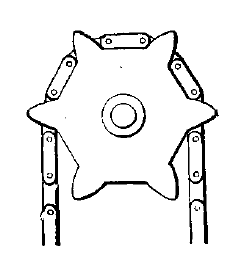 |
|
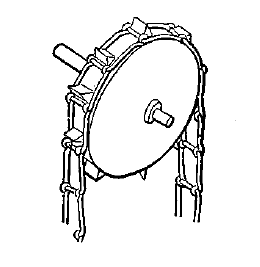 |
Toothed Link Chain and Pulley—
Step Gear—
 |
|
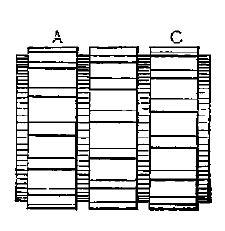 |
V-Toothed Gearing—
Oblique Tooth Gear—
V-Toothed Gear—
Split Spur Gear—
Star Wheel Gear—
Elastic Spur Gear—
Internal Spur Gear and Pinion—
Bevel Gears—
Crown Wheel—
Spiral Gearing—
Oblique, Spur, and Bevel Gear—
Oblique Bevel Gear—
Gear Train—
Worm Gear—
Skew Worm and Wheel Gear—
Uniform Intermittent Motion—
Variable Speed Bevel Gear—
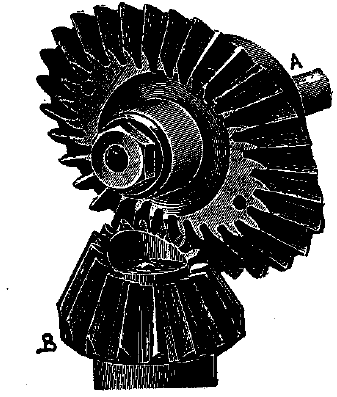
VARIABLE SPEED BEVEL GEAR—
A bicycle novelty. One revolution of A gives two revolutions of B. A is an elliptic bevel gear central on the shaft. B is an elliptic bevel gear of one-half the number of teeth of A and revolves on one of its elliptic centers. The cranks are set opposite to ,the short diameter of the driving gear A, giving greater power to the tread and quicker motion at the neutral points of the crank.
SECTION 3: MEASUREMENT OF POWER.
SPEED, PRESSURE, WEIGHT, NUMBERS, QUANTITIES, AND APPLIANCES
Prony Brake—
The Prony Brake Rule—
"Webber" Dynamometer—
Measurement of Power—
"Tatham's" Dynamometer—
Bell-Crank Dynamometer—
"Neer's" Rotary Transmitting Dynamometer—
"Van Winkle's" Power Meter—
Traction Recording Dynamometer—
Friction Machine—
Torsion Dynamometer—
Tensile Testing Machine—
Bourdon Pressure Gauge—
Corrugated Tube-Pressure Gauge—
Recording Pressure Gauge—
Parallel Motion of the Indicator—
Parallel Motion for the Indicator—
"Amsler" Planimeter—
"Lippincott" Planimeter Centrifugal Speed Indicator—
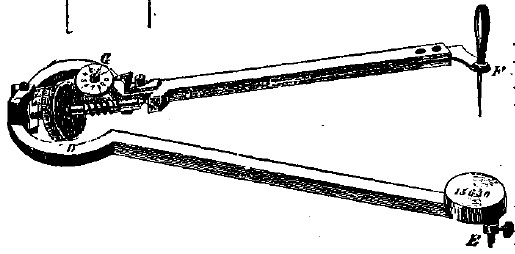 |
|
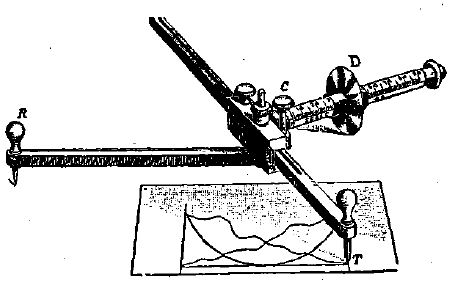 |
Speed Indicator—
Meter Dial—
Automatic Tipping Scale—
Double Link Balanced Scale—
Differential Weighing Beam—
Engine Counter—
Operation of a Counter—
Intermittent Rotary Motion—
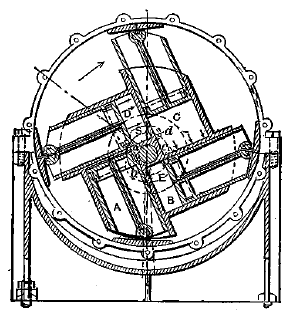 |
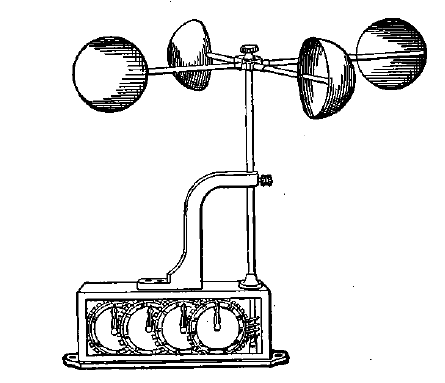 |
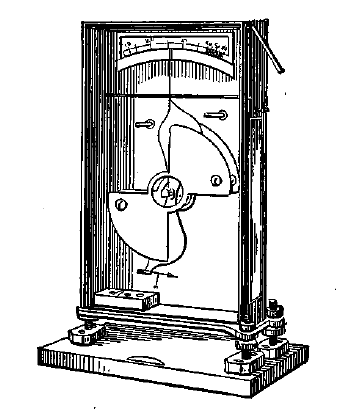 |
| ANEMOMETER FOR MEASURING AIR CURRENTS— A small windmill but a few inches in diameter geared to a series of dials which by known air velocities are graduated in cubic feet of air passed per minute. | ANEMOMETER FOR MEASURING THE VELOCITY OF THE WIND— The dial indexes are geared by tenths, as 1, 10, Too, 1,000 miles, which by differentiating the time gives the velocity of the wind in miles per hour. The ratio of the wind velocity to the center of the cup velocity is usually about 3 to 1. | ELECTROSTATIC VOLTMETER FOR MEASURING PRESSURES— An electrostatic voltmeter is shown herewith. In this form the meter is constructed to measure pressures up to 20,000 volts. |
Tire Measure Counter—
SECTION 4: STEAM POWER.
BOILERS AND ADJUNCTS, ENGINES, VALVES AND VALVE GEAR, PARALLEL MOTION GEAR, GOVERNORS AND ENGINE DEVICES, ROTARY ENGINES, OSCILLATING ENGINES. . . . 55 to 100
"Stevens" Boiler—
Plain Cylindrical Boilers—
Hanging Water Drum—
Cylindrical Boiler—
Cylindrical Double Flue Boiler—
Internally Fired Flue Boiler—
Horizontal Tubular Boiler—
Locomotive Boiler—
Marine Boiler—
"Eclipse" Return Tubular Marine Boiler—
"Galloway" Boiler—
Internal Fired Cylindrical Tubular Boiler—
"Dion" Vehicle Boiler—
"Babcock and Wilcox" Water Tube Boiler "Harrison" Boiler—
Submerged Head Vertical Boiler—
"Herreshoff " Boiler “Thornycroft" Boiler—
"See" Water Tube Boiler—
"Yarrow" Water Tube Boiler—
"Boyer's" Water Tube Boiler—
"Hazelton" Boiler—
"Climax Boiler—
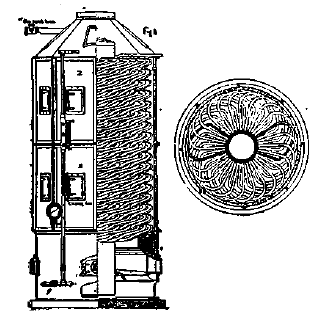
"CLIMAX" BOILER—
A central vertical water and steam drum, with bent tubes expanded in it, and inclined to facilitate circulation.
Moyes Water Tube Boiler—
"Wheeler" Vertical Tube Boiler—
"Cahall" Vertical Water Tube Boiler—
Vertical Water Tube Boiler—
Boiler of the "Serpollet" Tricycle—
"Serpollet's" Steam Generator—
"Serves" Boiler Tube—
Shaking and Tipping Furnace Grate—
Shaking Grate for a Boiler Furnace—
Furnace Grate with Dumping Sections—
"Columbia" Stoker—
"Playford" Mechanical Stoker—
"American" Boiler Stoker—
Mechanical Stoker—
"Jones" Model of a Mechanical Stoker—
"Meissner" Model of a Mechanical Stoker for a Furnace—
Feed Worm and Air Blast—
Petroleum Burner—
Pop Safety Valve—
Differential Seat Safety Valve—
Safety Valve—
Original Form of the Eolipile or Hero's Steam Engine—
Steeple Engine—
Vertical Engine, with Bell-Crank Lever—
Inclined Paddle Wheel Engine—
Diagonal Twin-Screw Engine—
Twin-Screw Vertical Cylinder Engine—
Trunk Engine—
Oscillating Engine—
Compound Oscillating, Engine—
Oscillating Hoisting Engine—
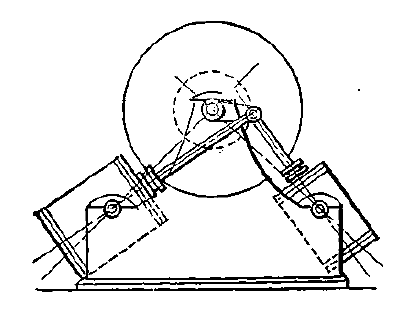 |
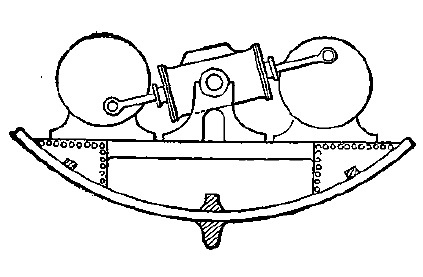 |
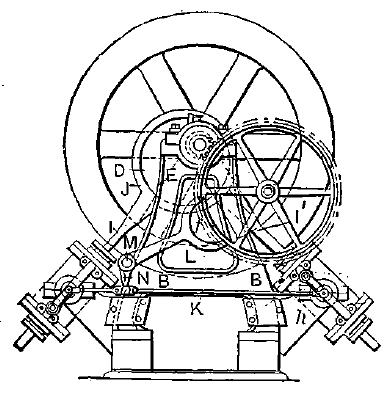 |
COMPOUND OSCILLATING ENGINE—Cylinders at right angles. |
TWIN-SCREW OSCILLATING ENGINE—A through piston rod connects directly to crank-pins on the-shaft face plates. Suitable for small boats. |
OSCILLATING HOISTING ENGINE—The piston rods are attached to an eccentric strap one fixed, the other pivoted. A lever operated by the same eccentric strap, through a short connecting rod, operates the valve gear of each cylinder alternately. |
Three-Cylinder Engine—
Tandem Compound Vertical Engine—
Compound Engines—
Compound Yacht Engine—
High-Speed Tandem Compound Engine—
Modern High-Speed Engine—
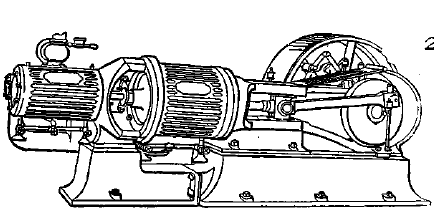 |
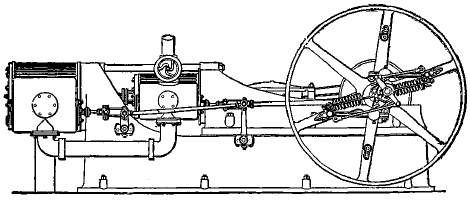 |
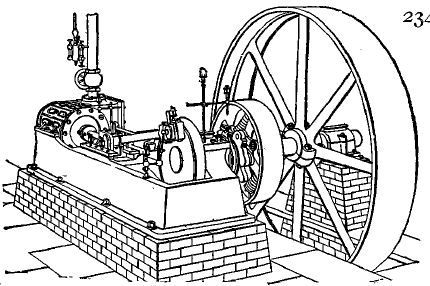 |
|
TANDEM COMPOUND ENGINE—"Phoenix Iron Works" model. A direct pipe connection between the high and low pressure cylinder |
MODERN HIGHSPEED ENGINE—with pulley governor, "Atlas" model. |
Single D Slide Valve—
Balanced Slide Valve—
Double-Ported Slide Valve—
"Meyer" Cut-off Valve—
Single D Slide Valve—
Gridiron Slide Valve—
Rotary Valves—
Steam Engine Valve Chest—
Balanced Slide Valve—
Balanced Slide Valve (Buchanan & Richter's Patent)—
"Richardson-Allen" Balanced Slide Valve—
Balanced Throttle Valve—
Wing Throttle Valve—
Multiple Port Piston Throttle Valve—
"Corliss" Valve Gear—
Locomotive Link-Motion Valve Gear—
Walschaert's Valve Gear—
Reversing Link Motion—
Valve Gear—
"Joy's" Valve Gear—
"Bremme" Valve Gear—
Single Eccentric Valve Gear—
Cam-Bar Valve Movement—
Valve Gear of a Cornish Engine—
Variable Expansion Gear—
Single Eccentric Variable Valve Throw—
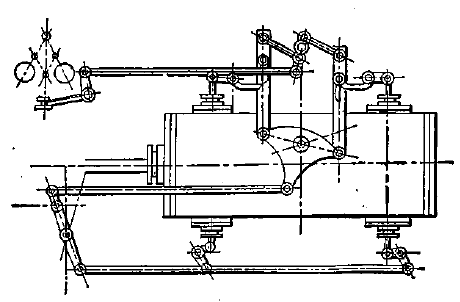 |
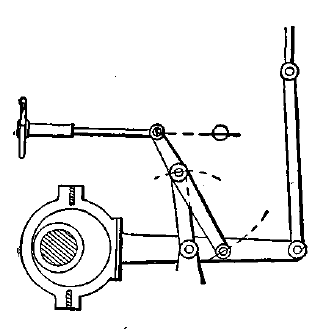 |
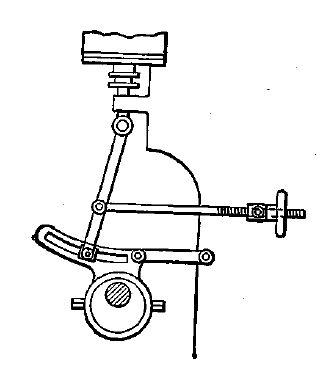 |
VALVE GEAR OF A CORNISH ENGINE—with trip poppet valves for steam. The governor releases the valves by varying the position of the vertical bars connected to the rocking wrist plate. Exhaust valves are operated from the eccentric through the lever that operates the steam valves. |
VARIABLE EXPANSION GEAR—with one eccentric. The movement of the fulcrum of the eccentric bar lever by the screw changes the throw of the valve. |
SINGLE ECCENTRIC VARIABLE VALVE THROW—"Fink" link gear for a D valve. The link block is moved in the curved slot of the link for variation of valve throw. adjustable by the hand-wheel. |
"Allen" Valve Lift or Toe—
Tappet Lever Valve Motion—
Starting Lever—
Simple ,Unhooking Device—
Simple Reversing Gear—
"Joy's" Hydraulic Shifting Eccentric—
Shifting Eccentric—
Valve Motion Eccentric—
"Peaucellier's" Parallel Motion—
Parallel Motion—
"Cartwright's" Parallel Motion—
Cross-Head Slide—
Rack Gear Parallel Motion—
"Watt" Governor—
Compensating Governor—
Gravity Centrifugal Governor—
Engine Governor—
Centrifugal Ball Governor—
Inverted Governor—
Direct-Acting Centrifugal Governor—
Spring Balanced Centrifugal Governor—
Parabolic Governor—
"Anderson's" Gyroscope Governor—
Horizontal Centrifugal Governor—
Vane or Wing Governor—
Governor for a Steam Engine—
Differential Governor—
"HuntoOn" Governor—
"Proell" Governor—
"Porter" Governor—
"Richardson" Governor—
Principle of the "Pickering" Governor —
"Pickering" Governor—
Pulley or Fly-Wheel Governor—
Crank-Shaft Governor—
Fly-Wheel or Pulley Governor—
Slotted Cross-Head—
Trammel CrankCrank-Pin Lubricator—
Centrifugal Crank-Pin Oiler—
Centrifugal Lubricating Device—
"Cochrane" Rotary Engine—
"Franchot" Rotary Engine—
Double Slide Piston Rotary Engine—
"Lamb" Rotary Engine—
"Cochrane" Rotary Engine—
Rotary Engine—
"Napuer" Rotary Engine—
Roller Piston Rotary Engine—
"Cochrane" Rotary Engine—
"Boardman" Rotary Engine—
"Smith" Rotary Engine—
"Berrenburg" Rotary Engine—
"Fletcher's" Rotary Condensing Engine—
"Bartrum and Powell" Rotary Engine—
"Ritter" Rotary Engine—
"Holly" Rotary Engine—
"Stocker" Rotary Engine—
"Forrester" Rotary Engine—
"Kipp" Rotary Piston Engine—
"Ruth's" Rotary Engine—
"Almond" Engine—
Rotating Cylinder Engine—
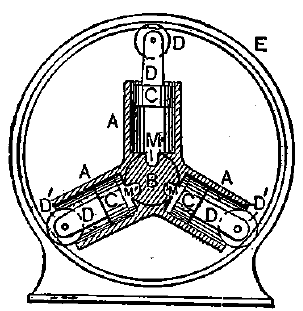 |
 |
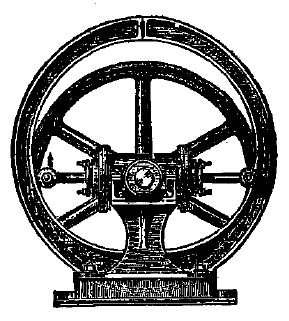 |
 |
"RUTH'S" ROTARY ENGINE—A revolving cylinder engine. Three cylinders, A, A, A, radiate from a shaft set eccentric to an outer circle or ring on which the piston connected sheaves revolve. The pistons take steam through the ports M, M, M, just past the shortest eccentric radius, and drives out the piston during a half revolution, when the exhaust is opened and the piston is pushed back by the eccentric ring. |
"ALMOND" ENGINE—Four single-acting cylinders set tangent to a shaft which is central to an outer shell. The pistons have jointed segmental plates at their outer end that press against the outer shell and cause the cylinders and shaft to revolve by the eccentric direction of their pressure. Disc ports for steam and exhaust. |
ROTATING CYLINDER ENGINE—The cylinder rotates on trunnions with a through piston rod terminating with rollers running in an oval ring. Steam and exhaust ports in the trunnion. Pressure of the piston-rod rollers on the oval ring revolves the cylinder and fly-wheel on its trunnion. |
ROTARY MULTI-CYLINDER ENGINE—Three or more cylinders are attached to and revolve with the fly-wheel. The crank is stationary and eccentric to the fly-wheel. Each cylinder is single-acting. Valves are on a central disc at A. |
Rotary Multicylinder Engine—
“Bates" Compound Vibrating Engine—
"Davies" Disc Engine—
"Reuleaux" Engine or Pump—
"Link" Vibratory Engine—
Oscillating Piston Engine —
Vibrating Piston Engine—
"Knickerbocker" Four Piston Rotary Engine—
"Root's" Double Quadrant Engine—
"Root's" Square Piston Engine—
"Dake" Square Piston Engine—
"Wilkinson's" Steam Turbine—
"Dow" Steam Turbine—
"De Laval" Steam Turbine—
"Parsons" Steam Turbine—
SECTION 5: STEAM APPLIANCES.
INJECTORS, STEAM PUMPS, CONDENSERS, SEPARATORS, TRAPS, AND VALVES
"Peerless" Injector—
“Shaeffer and Budenberg" Injector—
“National" Automatic Injector—
"Metropolitan" Injector—
"Lunkenheimer" Injector—
"Eberman" Injector—
"Nathan" Injector—
"Little Giant" Injector—
"Penberthy" Special Injector—
"Park" Injector—
"Sellers" Restarting Injector—
"Little Giant" Locomotive Injector—
"Metropolitan" Double-Tube Injector—
“Brownley" Injector—
"Leader" Injector—
"Excelsior" Injector—
"Korting" Injector—
"Hancock" Inspirator—
Ball-Valve Injector—
"Hancock" Locomotive Inspirator—
"Standard" Injector—
"Sellers" Self-Adjusting Injector—
Steam Pump—
"Misch's " Valve Tappet—
Independent Jet Condenser Pump—
Ejector Condenser—
Exhaust Jet Condenser—
Balanced Reducing Valve—
Pressure Reducing Valve—
"Foster" Pressure Reducing Valve—
"Hotchkiss" Boiler Cleaner—
Feed-Water Heater—
Steam Separator—
Filter for Boiler—
Return Steam Trap—
Spring Steam Trap—
Steam Trap—
"Bundy" Steam Trap—
Steam Trap with Valve—
"Heintz" Steam Trap—
"Moran's" Flexible Steam Joint—
Corrugated Expansion Coupling—
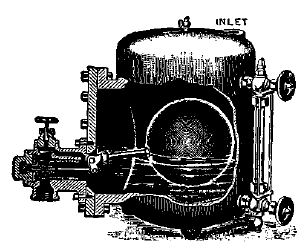 |
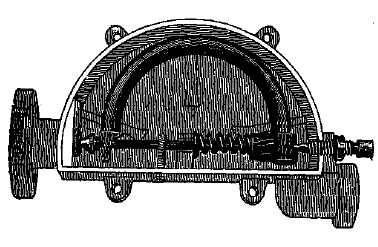 |
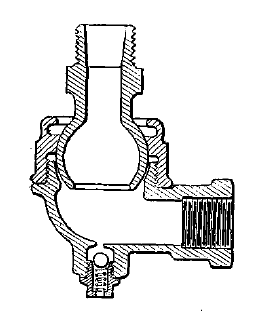 |
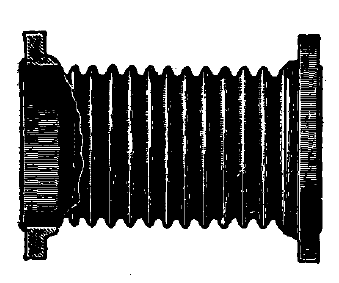 |
|
|
“MORAN ' S" FLEXIBLE STEAM JOINT—and automatic relief valve. A ground globular pipe fitting held in a spherical union joint. |
CORRUGATED EXPANSION COUPLING—"Wainwright's" model. A hard brass tube, corrugated, gives the tube a longitudinal elasticity to take up the expansion of steam pipes. |
Flanged Expansion Joint—
Auto. matic Relief Valve—
Horizontal Swing Check Valve—
Globe Valve—
Exhaust Steam Head—
Centrifugal Exhaust Head
SECTION 6: MOTIVE POWER.
GAS AND GASOLINE ENGINES, VALVE GEAR AND APPLIANCES, CONNECTING RODS AND HEADS
Gasoline Engine—
Sectional Plan of a Gasoline Engine—
Simple Gas or Gasoline Engine—
Gasoline Engine Valve Gear—
"Union" Model Gas Engine—
Gasoline Carriage Motor—
Vertical Gasoline Engine—
Vertical Kerosene Oil Engine—
"Diesel" Motor—
Vertical Gas Engine—
Street Railway Gas Motor Passenger Car—
Gasoline Motor Car—
Valve Gear—
Double-Grooved Eccentric Valve Gear for a Four-cycle Gas Engine—
Plumb-Bob Governor—
Inertia Governor—
Pendulum Governor—
Differential Cam Throw—
Governor and Variable Cam—
Inlet Valve—
Gas Engine Valve Gear—
Gasoline Vaporizer—
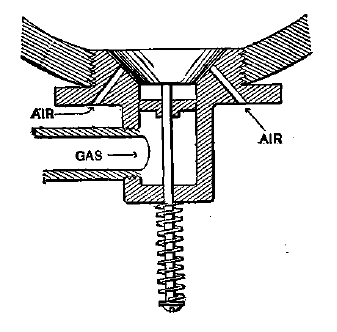 |
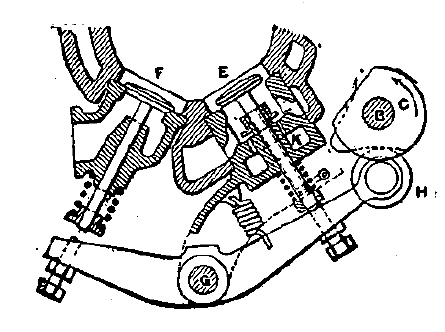 |
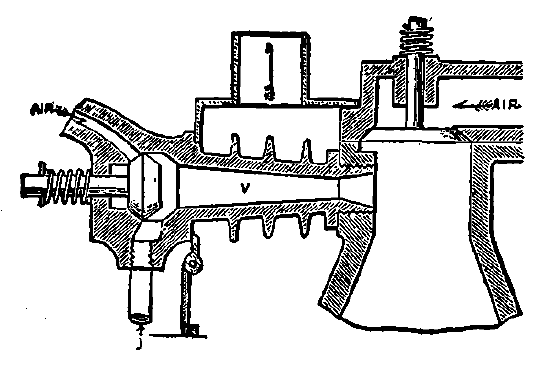 |
INLET VALVE FOR GAS ENGINE—A valve disc slightly held in contact with the seat by the spring. Air holes should be drilled close together around the valve seat, so that combined air area shall be larger than the area of the gas- inlet. |
GAS ENGINE VALVE GEAR—E, Inlet valve ; F, exhaust valve. Valves are operated by a bent lever, with sliding roller H and double cam C, which by a groove rides the roller alternately on to the cams. |
GASOLINE VAPORIZER—The inlet nozzle, V, is ribbed on the outside and is enclosed in a chamber through which the exhaust passes. Gasoline and air are drawn into the nozzle regulated by the small valve, and additional air for the explosive mixture is drawn by the piston through the large valve. "Capitaine" motor. |
Carburetter—
Automatic Oiler—
Uniform Automatic Oiler—
Crank-Rod Head Adjustment—
Trunk Piston Rod—
Connecting Rod Head—
Connecting Rod End—
Solid Strap End—
Steel Ball Adjustment—
Solid End Connecting Rod—
Forked End Connecting Rod—
Adjustable Link—
Link or Connecting Rod—
SECTION 7: HYDRAULIC POWER AND DEVICES.
WATER WHEELS, TURBINES, GOVERNORS, IMPACT WHEELS, PUMPS, ROTARY PUMPS, SIPHONS, WATER LIFTS, EJECTORS, WATER RAMS, METERS, INDICATORS, PRESSURE REGULATORS, VALVES, PIPE JOINTS, FILTERS
Overshot Water Wheel—
Iron Overshot Wheel—
Undershot Water Wheel—
Saw-Mill Water Wheel—
Breast Water Wheel—
Flutter Wheel—
Barker Wheel—
Current Motor—
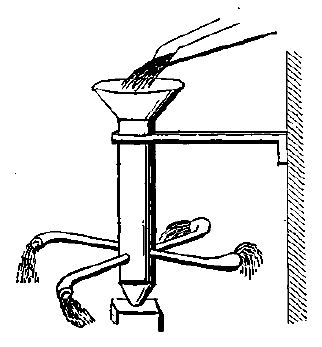 |
|
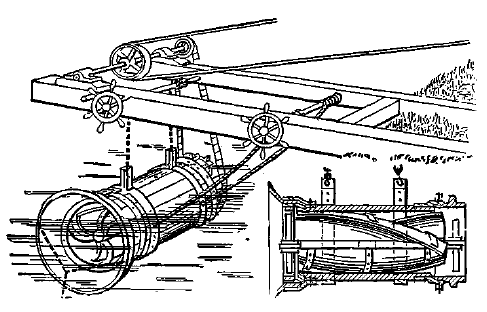 |
Current Water Wheel—
Fixed Bucket Water-Raising Current Wheel—
Bucketed Water-Raising Current Wheel—
Current Wheel Water Lift—
Drainage Wheel—
Persian Wheel—
Ancient Water Lift—
"Archimedian" Screw Water Lift—
Volute Turbine—
High-Pressure Turbine—
"Leffel" Double-Runner Turbine—
"Jonval" Turbine—
Turbine and Gate—
"Lancaster” Turbine—
"Munson" Double Turbine—
"Camden" Turbine—
"Model" Turbine—
"Swain" Turbine—
"Wanen" Central Discharge Turbine—
"Fourneron" Turbine—
Belt Water-Wheel Governor—
Water Wheel Governor—
Impact Water Wheel—
Pelton Water Wheel—
Buckets of a Pelton Water Wheel—
Power of Water—
Compound Beam Pumping Engine—
"Dean" Steam Pump—
Worthington Duplex Pump—
Half-Yoke Connection—
Yoke Connection—
Reversing Movement—
Double-Acting Lift and Force Pump—
Double-Acting Differential Pump—
Lift and Force Pump—
Tramp Pumping Device—
Lift Pump—
Double Lantern Bellows Pump or Blower—
Diaphragm Pump—
"Fairburn" Bailing Scoop—
Pendulum Water Lift—
Chain Pump—
Reciprocating Motion—
Well Pulley and Buckets—
Swape, or New Engine Sweep—
Parallel Motion "Golding" Centrifugal Pump—
"Quimby" Screw Pump—
Rotary Pump—
"Pappenheim" Rotary Pump—
"Repsold" Rotary Pump—
Tri-Axial Rotary Pump —
Rotary Pump or Motor—
"Cary" Rotary Pump—
Vacuum Jet Condenser and Rotary Pump—
"Ramelli" Rotary Pump—
"Heppel" Rotary Pump—
"Emeru" Rotary Pump—
"Knott" Rotary Pump—
"Pattison" Rotary Pump—
"Cochrane" Rotary Pump—
Hydraulic Transmission of Power—
Siphon Ejector or Jet Pump—
Automatic Water Ejector—
Automatic Sprinkler—
Hydraulic Ram—
"Pearsall's" Hydraulic Ram and Air Compressor—
Silent Hydraulic Ram—
Double-Piston Reaction Hydraulic Ram—
Water Meter—
Disc Water Meter—
Water Velocity Indicator and Register—
Anchored Ferry Boat—
"Mueller" Water-Pressure Regulator—
"Mason" Water-Pressure Regulator—
Pump Water-Pressure Regulating Valve—
Hydraulic Press—
Hydrostatic Press—
Hydraulic Intensifier—
Portable Hydraulic Riveter—
Hydraulic Rail Bender—
Hydraulic Rail Punch—
Hydraulic Elevator Lift—
Horizontal Hydraulic Elevator Lift—
Hydraulic Pulling Jack—
Water Purifying Filter—
Reversible Filter—
Filtering Cistern—
Upward Flow Filter—
Domestic Filter—
Porous Water Filter—
Stoneware Filter—
"Ward" Flexible Pipe Joint—
Flexible Ball joint—
Flexible Pipe Joints—
Universal Pipe Joint—
Toggle Clip Pipe Joint—
Disc Valve and Guard—
Double-Beat Disc Valve—
Hydraulic Valve—
Multiple Ball Valve—
Multiple Ring Valve—
Double-Beat Pump Valve—
Vibrating Motion—
Variable Compensating Weights—
Sand Auger—
Driven Well—
Automatic Flush Sewer Tank—
Atomizer—
Ball and Jet Nozzle—
Spray Jet Nozzle—
Hero's Fountain—
"Chapman" Aspirator or Vacuum Pump—
Hydraulic Lift—
SECTION 8: AIR POWER APPLIANCES.
WINDMILLS, BELLOWS, BLOWERS, AIR COMPRESSORS, COMPRESSED AIR TOOLS, MOTORS, AIR WATER LIFTS, BLOWPIPES
Aneroid Barometer, Box Kite—
Curved Vane Windmill or Motor—
Feathering Windmill—
Hemispherical Cup Windmill—
Windmill of our Grandfathers—
Windmill and Steel Tower—
Modern Windmill—
Ancient Windmill—
Electric Windmill Plant—
Smith's Circular Bellows—
Double Organ-Blowing Bellows—
Three-Throw Bellows—
Foot Bellows—
Fan Blower—
"Hodges" Compound Blower—
"Wedding" Rotary Blower—
"Fabry" Rotary Blower—
"Root" Rotary Blower—
Hydraulic Air Compressor—
Piston Hydraulic Air Compressor—
Tromp or Hydraulic Air Blast—
Air Compressor Hydraulic Air Compressor—
Automatic Air Compresson—
 |
DUPLEX STEAM ACTUATED AIR COMPRESSOR—"Ingersoll-Sergeant" model. The air cylinders are tandem to each steam cylinder with steam and air governors. |
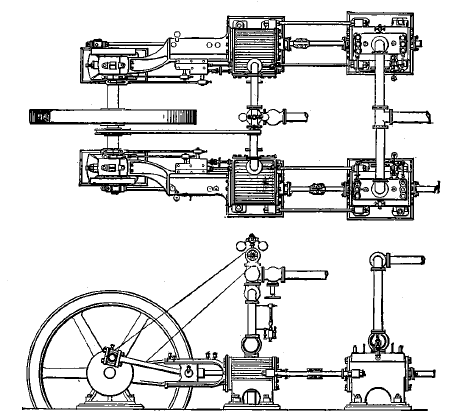 |
Water-Jet Air Compressor—
Trunk Air Compressor—
Duplex Steam-Actuated Air Compressor—
Compound Air Compressor—
Duplex Air Compressor—
Toggle Joint Duplex Air Compressor—
Air Compressor Cylinder—
Piston and Valves—
Air-Compressing Cylinder—
Air Compressor Governor—
Air-Cooling Receiver—
Single Valve Air Pump—
Crank Equalizing Angle—
Crank Equalizing Angle in Air Compression—
Direct Air Pressure Pump—
Compressed Air Water Elevator—
Raising Sunken Vessels—
Compressed Air Lift System—
Compressed Air Power—
Compound Pneumatic Locomotive—
Pneumatic Paint Sprayer—
Portable Fire Extinguisher—
Fire Extinguisher—
Compressed Air Lift—
Duplex Pneumatic Riveter—
Pneumatic Hammer—
"Hotchkiss" Atmospheric Hammer—
"Grimshaw" Compressed Air Hammer—
Compressed Air Sheepshearing Machine—
Portable Riveter—
Pneumatic Portable Riveter—
Pneumatic Breast Drill—
Pneumatic Motor Drill Stock—
Air and Gasoline Torch—
Torch Soldering Copper—
Air and Gasoline Vapor Brazer—
Air and Gasoline Brazing Apparatus—
Double Cone Ventilator—
Spiral Vane or Cowl—
Wind Instruments—
SECTION 9: ELECTRIC POWER AND CONSTRUCTION.
GENERATORS, MOTORS, WIRING, CONTROLLING AND MEASURING, LIGHTING, ELECTRIC FURNACES, FANS, SEARCHLIGHT, AND ELECTRIC APPLIANCES
Series Wound Motor or Generator—
Electric Generator Construction—
Single Pole Shunt Generator—
Four-Pole Ring Armature—
Ring Armature—
Two-Pole or Shuttle Spool Armature—
Shuttle Armature—
Multiple Brush Commutator—
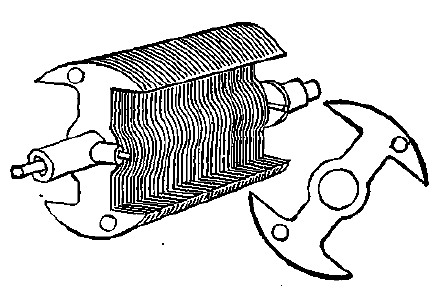 |
|
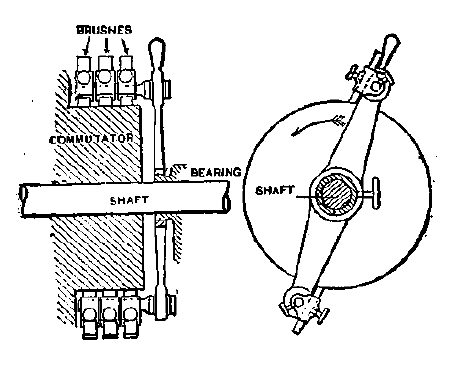 |
Bipolar Shunt Generator—
Four-Pole Compound Generator—
Electric Generator Construction—
Consequent-Pole Compound Generator—
Triple-Expansion Engine and Multi-polar Dynamo—
Direct-Connected Vertical Compound Engine—
Flexible Coupling—
Car Truck Motors—
Electric Fusible Cut-Out—
Rheostat or Resistance Coils—
Trolley Car—
Sectional Feeder System—
Street Railway Single Motor—
Electric Car Brake—
Electric Street-Car Brake—
Electric Igniter—
Sparking Dynamo—
Magneto-Electric Machine—
Electric Thermostat—
Telephone Transmitter—
Telephone Receiver—
Electric Gas Lighter—
Pocket Electric Light—
Arc Light and Regulating Gear—
Luminous Fountain—
Electric Heater—
Electric Soldering Copper—
Electric Sad Iron—
Electric Searchlight—
Electric Furnace—
Open-top Electric Furnace—
"Siemens" Electric Gas Furnace—
"Cowles" Electric Furnace—
Electric Welding Plant—
Portable Electric Motor Drill Plant—
Electric Perforating Pen—
Electric Hoist—
Electric Brake—
Electric Rock Drill—
Electric Fan—
Electric-Driven Fan—
SECTION 10: NAVIGATION AND ROADS.
VESSELS, SAILS, ROPE KNOTS, PADDLE WHEELS, PROPELLERS, ROAD SCRAPERS AND ROLLERS, VEHICLES,, MOTOR CARRIAGES, TRICYCLES, BICYCLES, AND MOTOR ADJUNCTS
Leg-of-Mutton Sail—
Skip Jack—
Square or Lug Sail—
Lateen Rig—
Split Lug or Square Sail—
Two-Masted or Dipping Lug—
Newport Cat-Boat—
Sloop—
Lateen-Rigged Felucca—
Pirogue—
Three-Quarter Lug Rig—
"Sliding Gunter"—
Skiff Yawl Rig—
Sloop Yawl—
Jib Topsail Sloop—
The Cutter—
Schooner Rig—
Full Schooner Rig—
Topsail Schooner—
Club Topsail Rig—
Hermaphrodite Brig—
A Brigantine—
A Barkentine—
Full-Rigged Brig—
A Bark—
Full Rigged Ship—
Ice Boat—
Rope Knots and Hitches—
Clove Hitch—
Half Hitch—
Timber Hitch—
Square or Reef Knot—
Stevedore Knot—

Slip Knot—
Fleming Loop—
Bowline Knot—

Carrick Bend—
Sheet Bend and Toggle—

Sheet Bend—
Overhand Knot—
Figure Eight Knot—
Double Knot—
Blackwall Tackle Hitch—
Fisherman's Bend Hitch—
Round Turn and Half Hitch—
Chain Stop—
Disengaging Hook—
Slip Hook—
Releasing Hook—
Boat-Detaching Hook—
Swinging Oar-lock—
Pivoted Steps—
Screw Anchor—
Floating Lighthouse—
Stone Dry-Dock—
Floating Dry-Dock—
Feathering Paddle Wheel or Water Motor—
Vertical Bucket Paddle Wheel—
Feathering Paddle Wheel—
Outward Thrust Propeller Wheel—
Screw Propeller—
Reversing Propeller—
Reversing Screw Propeller—
Screw Propulsion—
Thrust Bearing—
"Silver's" Marine Governor—
Deep-Sea Sounding Ball—
Sounding Weight Release—
Sampler Sounding Weight—
Submarine Lamp—
Road Builders' Level—
Road Machine—
Reversible Road Roller—
Road Roller—
Single Eccentric Reversing Gear—
Elastic Wheel—
Spring Wheel—
Application of Trace Springs—
"Serpollet's" Steam Tricycle—
Steam Fire Engine—
Jacketless Gasoline Carriage Motor—
Gasoline Motor Carriage—
Light Electric Carriage—
Electric Phaeton—
Electric Brougham—
Differential Gear—
Baby-Carrier Tricycle—
Electric Tricycle—
Ice Bicycle—
Bicycle Gear—
Bicycle Crank—
Swinging Ball-Bearing Bicycle Pedal—
A. F. Haven's Planetary Crank Gear—
Detachable Link Chain—
Ball-Bearing Problem—
Acetylene Bicycle Lamp—
Bicycle Lamp—
SECTION 11: GEARING.
RACKS AND PINIONS; SPIRAL, ELLIPTICAL AND WORM GEAR; DIFFERENTIAL AND STOP-MOTION GEAR; EPICYCLICAL AND PLANETARY TRAINS; “FERGUSON'S” PARADOX
Ordinary Rack and Pinion—
Doubling the Length of a Crank Stroke—
Sawmill Feed—
Rack Motion—
Air-Pump Movement—
Circular Rack—
Rectilinear Vibrating Motion—
Vertical Drop Hammer—
Sector Pinion and Double Rack—
Reciprocating Motions—
Crank Substitute—
Alternate Circular Motion—
Quick Back Motion—
Alternate Rectilinear Motion—
Reciprocating Rectilinear Motion—
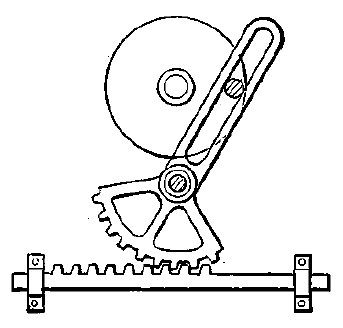 |
 |
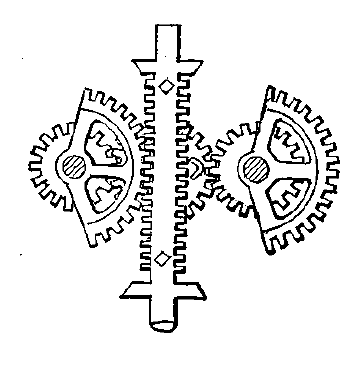 |
|
|
|
Mangle Rack—
Mangle Wheel—
Mangle Wheel Gear—
Continuous Rotary Motion—
Mangle Machine Gear—
Worm Screw Rack—
Rotary Motion—
Adjustable Feed Rolls—
Saw-Tooth Worm Gear—
Right- and Left-Hand Worm Gear—
Three-Part Worm Screw—
Traversing Motion—
Globoid Spiral Gear Wheels—
Internal Worm-Gear Wheel—
Worm-Gear Pinion—
Anti-Friction Worm Gear—
Release Rotary Motion—
Release Cam—
Hunting Tooth Worm Gear—
Differential Screw and Gear Movement—
Complex Alternating Reciprocal Motion—
Two-Toothed Pinion—
Pin Wheel and Slotted Pinion—
Variable Rotary Motion—
Scroll Gear—
Spiral Hoop Gear—
Accelerated Circular Motion—
Roller-Bearing Gear Teeth—
Ball Gear—
Spiral Gearing—
Expanding Pulley—
Concentric Differential Speed—
Differential Motions—
Differential Gear—
Doubling the Number of Revolutions on One Shaft—
Multiple Gear Speed—
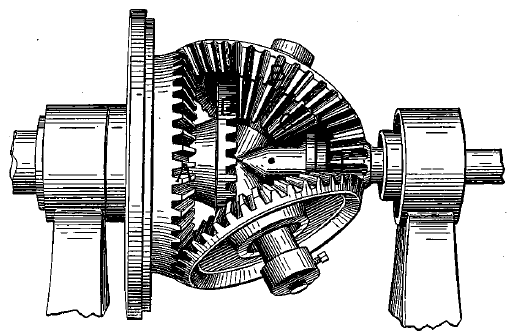
MULTIPLE GEAR SPEED IN LINE OF SHAFT—
Pinion E is fast on small shaft. B and C are fast together and pivoted on the y sleeve which runs loose on an extension of the small shaft gear; D is fast on the large shaft, and gear A is fixed to the bearing. Speed may thus be increased or decreased on a continuous line of shafting by the relative number of teeth in the different bevel gears. When the multiple of the teeth in A and C is less than the multiple of the teeth in B and D, the gear D and the large shaft will revolve forward or in the same direction as the pinion E. When the multiple of A and C is greater than the multiple of the teeth in B and D, the gear D and large shaft will revolve backward or in the opposite direction from the pinion E. The "Humpage" reducing gear
Variable Throw Traversing Bar—
Revolution of a Pinion—
Differential Speed—
Capstan Gear—
Slow Forward and Quick Back Circular Motion—
L-Geared Grip Tongs—
Variable Circular Motion—
Elliptical Spur Gear—
Elliptical Gear Wheel—
Irregular Circular Motion—
Variable Reciprocating Motion—
Alternating Rectilinear Motion—
Intermittent Motion of Spur Gear—
Spiral Stop-Motion Gear—
Fast and Slow Motion Spur Gear—
Intermittent Gears—
Intermittent Rotary Motion—
Irregular Vibratory Motion—
Variable Vibrating Motion—
Motion by Rolling Contact—
Variable Sectional Motion—
Uniform Speed of Sectional Spur Gear—
Scroll Gearing—
Intermittent Rotary Motion—
Stop Roller Motion—
Change Gear Motion—
Differential Driving Gear—
Equalizing Pulley—
Equalizing Gear—
Doubling a Revolution on Same Shaft—
Continuous Shaft Motion—
Alternating Motion—
Eccentric Wheel Train—
Epicyclic Gear—
Epicyclic Train—
Automatic Clutch Motion for Reversing—
Eccentric Gear—
Sun and Planet Crank Motion—
High-Speed Epicyclic Train—
Sun and Planet Winding Gear—
Epicyclic Gear Train—
Compound Epicyclic Train—
Planetary Motion—
Planetary Gear Train—
"Ferguson's" Mechanical Paradox—
SECTION 12: MOTION AND DEVICES CONTROLLING MOTION.
RATCHETS AND PAWLS, CAMS, CRANKS, INTERMITTENT AND STOP MOTIONS, WIPERS, VOLUTE CAMS, VARIABLE CRANKS, UNIVERSAL SHAFT COUPLINGS, GYROSCOPE
Ratchet Bar Lift—
Ratchet Lift—
Ratchet Governor—
Rotary Motion—
Intermittent Circular Motion—
Intermittent Rotary Motion—
Double Pawl Ratchet—
Continuous Feed of a Ratchet—
Double-Pawl Ratchet Wheel—
Intermittent Rotary Motion—
Intermittent Circular Motion—
Ratchet Intermittent Motion—
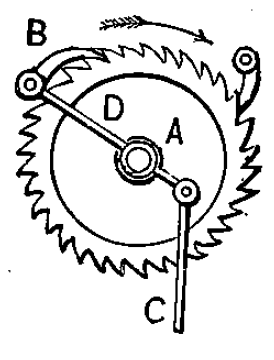 |
|
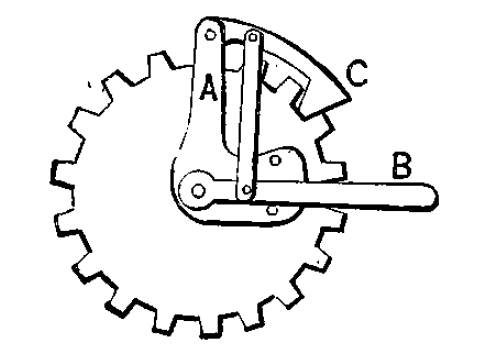 |
Pawl Lift—
Oscillating Motion—
Continuous Rotary Motion—
Intermittent Motion—
Windlass Grip Pawl—
Ratchet and Level Pawl—
Internal Multiple Cam—
Ratchet Head—
Reciprocal Circular Motion—
Ball Socket Ratchet—
Continuous Motion Ratchet—
Stops of Various Forms—
Stops for a Spur Gear—
Stops for a Lantern Wheel—
Safety Centrifugal Hooks—
Crank Motion—
Centrifugal Safety Catch for Hoisting Drums—
Stop Motion—
Variable Reciprocating Motion—
Irregular Rocking Motion—
Rocking Arm—
Yoke Strap—
Triangular Curved Eccentric—
Triangular Eccentric—
Reciprocating Motion Uniform Reciprocating Motion—
Needle-Bar Slot Cam—
Slotted Yoke—
Crank Motion—
Trammel Gear—
Slotted Lever Motion—
Intermittent Reciprocating Motion—
Variable Crank Throw—
Variable Adjustment—
Four-Bolt Cam—
Equalizing Tension Spring and Lever—
Alternating Rectilinear Motion—
Traverse Bar—
Rectilinear Motion—
Intermittent Rotary Motion—
Vibrating Toothed Wheel—
"Lazy Tongs" Movement—
Quadrangular Rectilinear Motion—
Parallel Motion—
Intermittent Motion—
Rocking Escapement—
Rotary and Longitudinal Motion—
Reciprocating Feed Ratchet—
Friction Rod Feed Ratchet—
Friction Hauling Ratchet—
Cam-Lever Grip—
Lever Toggle Joint—
Single Toggle Arm Letter-Press—
Toggle-Joint Cam Movement—
Double-Screw Toggle Press—
Screw Stamping Press—
Multiple Return Grooved Cylinder—
Reciprocating Rectilinear Motion—
Rectilinear Motion—
Six Radial Grooved Trammel—
Rectilinear Reciprocating Motion—
Rocking Motion—
Pair of Toe Levers—
Wiper Cam for Stamp Mills—
Angular Wipers—
Equalizing Levers or Toes—
Variable Crank Motion—
Spiral-Grooved Face Plate—
Lever—
Cam SectorsGear-Disengaging Cam Lever—
Oblique Disc Motion—
Grooved Cylinder Cam—
Traverse Motion—
Four-Motion Feed, of Wheeler and Wilson and other Sewingmachines—
Reciprocating Rectilinear Motion—
Quick Reciprocating Rectilinear Motion—
Cylindrical Cam—
Cam-Operated Shears—
Irregular Cam Motion—
Vibrating Rectilinear Motion—
Irregular Vibrating Circular Motion—
CloverLeaf Cam—
Power Escapement—
Rotary Motion—
Irregular Reciprocating Motion—
Bevelled Disc Cam—
Grooved Heart Cam—
Heart-Shaped Groove—
Laying out a Heart Cam—
Cam Motion—
Double Cam Motion—
Pivoted Follower—
Reciprocating Motion—
Ovoid Curve—
Variable Power Transmitted from a Crank—
Elliptical Crank—
Curvilinear Motion—
Spring Lathe-Wheel Crank—
"Brownell" Crank Motion—
Ordinary Crank Motion—
Eccentric and Straps for Valve Motion—
Reciprocating Motion—
Variable Circular Motion—
Irregular Motion—
Variable Power Vibrating Movement—
Variable Crank Pin—
Variable Rectilinear Motion—
Variable Crank Throw—
Variable Radius Lever—
Combination Crank-Motion Curves—
Flexible Angular Coupling—
Sliding Contact—
Shaft Coupling—
Rectilinear Motion—
Angular Shaft Coupling—
Universal Joint—
Double Link Universal Joint—
Universal Angle Coupling—
"Almond" Angular Shaft Coupling—
"Hooke's" Angular Shaft Coupling—
Rack and Pinion Movement—
Gyroscope—
Globe Gyroscope—
Tension HelicoVolute Spring—
Double Helico-Volute Spring—
Compression Helical Spring—
Single Volute Helix Spring—
Compound Disc Spring—
SECTION 13: HOROLOGICAL.
CLOCK AND WATCH MOVEMENTS AND DEVICES
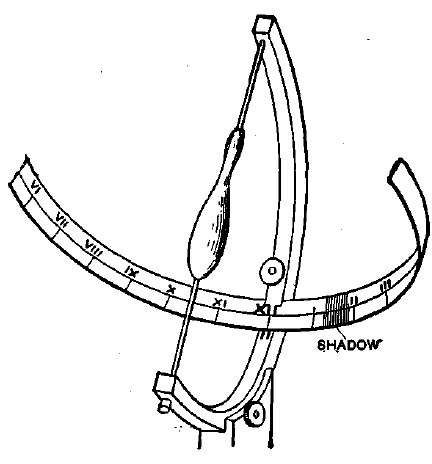
EQUATED SUNDIAL—
The curved bulbs on the shadow stile are made to conform to the equation of solar time. The end of the upper bulb represents the sun's declination at the summer solstice, the lower end of the large bulb the winter solstice of the shadow on the gnomon. The following edge of the shadow is the correct time when the 'sun is fast, the middle of April to the middle of June, and from September 1 to December 24. The forward edge of the shadow is the correct time from the middle of June to September 1, and from December 24 to the middle of April.
Cycloidal Pendulum Movement—
Compensating Pendulum Bob—
Compound Compensating Pendulum—
Centrifugal Pendulum—
Antique Clock Escapement—
Crown Tooth Escapement—
Double Ratchet-Wheel Escapement—
StarWheel Escapement—
Anchor Escapement—
Recoil Escapement—
Pendulum Escapement—
Stud Escapement—
Lantern-Wheel Escapement—
Pin-Wheel Escapement—
Hook-Tooth Escapement—
Single-Pin Pendulum Escapement—
Three-Toothed Escapement—
Detached Pendulum Escapement—
Mudge Gravity Escapement—
Tri-Toothed Pendulum Escapement—
"Harrison" Winding Device—
Double Tri-Toothed Pendulum Escapement—
"Bloxam's" Gravity Escapement—
Dead-Beat Clock Escapement—
Endless Cord Winding Device for Clocks—
Clock Train—
Compensation Watch Balance—
Watch Regulator—
Antique Watch Escapement—
Verge Escapement—
Cylinder Escapement—
Duplex Escapement—
Jeweled Detached Lever Escapement—
"Guernsey" Escapement—
Anchor and Lever Escapement—
Lever Escapement—
Lever Chronometer Escapement—
"Arnold" Chronometer Escapement—
Fusee Chain and Spring Drum—
Chronometer Escapement—
"Geneva" Stop—
Geared Watch Stop—
Watch Stop—
Stem-Winding Movement—
Pin-Geared Watch Stop—
Watch Train—
SECTION 14: MINING.
QUARRYING, VENTILATION, HOISTING, CONVEYING, PULVERIZING, SEPARATING, ROASTING, EXCAVATING, AND DREDGING
Diamond Prospecting Drill—
Rock Drill—
Diamond Well-Boring Machine—
Portable Diamond Drill—
Arc Tappet Valve Motion—
Tappet Valve, for a Rock Drill—
Rock Drill—
Rock Drill with Balanced Piston Valve—
Coal-Cutting Machine—
Link Chain Cutter—
Drill for Curved Holes—
Box-Wing Blower—
Multiplex Butterfly Valve—
Steam-Driven Ventilating Fan—
Miner's Safety Lamp—
Horse-Power Hoisting Drum—
Steam Hoisting Engine—
Strap Brake—
Elevator Tower—
Horizontal Boom Tower—
Mast and Gaff Hoist—
Coal-Loading Tipple—
"Otis Stop" for Elevator Cars—
Elevator Dumping Head—
Mining Buckets and Skip—
Belt Conveyer—
Chain Scraper Conveyer—
Cable Conveyer—
Driving Mechanism—
Log Conveyer—
Rope Tramway—
Automatic Dumping Car—
Toggle Joint—
Stone Crusher—
"Buchanan" Rock Crusher—
Roller Coal Crusher—
Eight-Stamp Ore Mill—
Rolling Crusher—
"Arastra" Ore Mill "Chili" Mill—
Pulverizing Ball and Pan Mill—
Revolving Pulverizing Mill—
Hydraulic Balanced Giant Nozzle—
Coal Dust Press—
Klondike Mining Machine—
Gold Separator—
Centrifugal Separator—
Magnetic Ore Separator—
Iron Ore Separator—
Railway Steam Shovel—
Magnetic Ore Separators (Hoffman-Edison Types)—
Ore Roasting Furnace—
Railway Excavator—
Railway Steam Shovel—
Continuous Ditching Dredge—
Clam-Shell Bucket—
Revolving Hoisting Dredge—
Floating Dredge—
Marine Dredge—
SECTION 15: MILL AND FACTORY APPLIANCES.
HANGERS, SHAFT BEARINGS, BALL BEARINGS, STEPS, COUPLINGS, UNIVERSAL AND FLEXIBLE COUPLINGS, CLUTCHES, SPEED GEAR, SHOP TOOLS, SCREW THREADS, HOISTS, MACHINES, TEXTILE APPLIANCES
Adjustable Bracket Hanger—
Adjustable Floor Bearing—
Adjustable Post Hanger—
Adjustable Floor Stand—
Continuous Traversing Roller—
Roller Wheel Anti-Friction Bearing—
Ball Bearings—
Adjustable Hanger for Shafting—
Screw Traversing Ball Bearing—
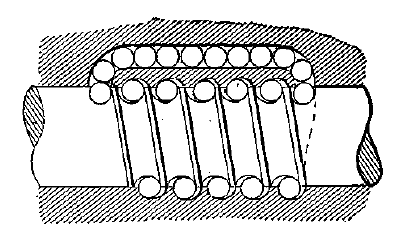 |
|
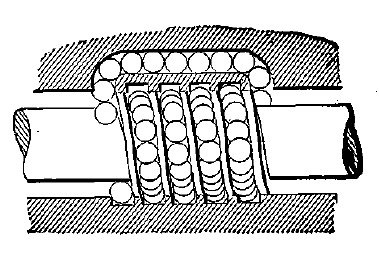 |
Hanging Shaft—
Suspended Shaft—
Curved Step Bearing—
Conical Pivot Bearing—
Lubrication of a Hanging Bearing—
Vertical Shaft Step—
Shaft Step Adjustment—
Adjustable Step Bearing—
Collar Bearing and Step—
Oil Circulating Step—
Lenticular Bearing—
Spherical Step Bearing—
Angle Coupling—
"Oldham" Coupling—
Flexible Link Coupling—
Flexible Shaft Coupling—
Angle Shaft Coupling—
Universal Joint—
"Hooke's" Universal Joint—
"Goubet's" Universal Shaft Coupling—
Ball Socket Universal Joints—
Right-Angle Shaft Coupling—
Right-Angle Shaft Coupling ("Hobson" Patent)—
Eccentric Line Coupling—
Simple Friction Pulley—
Friction ClutchV—
Grooved Face Clutch—
Clutch and Gear—
Cone Clutch—
Multiple Plate Friction Clutch—
Pin Clutch—
Friction Pin Clutch—
Friction Clutch Bevel Gear—
Spring Friction Clutch—
Double Toggle-Joint Friction Clutch—
Adjustable Friction Clutch—
Double Conic Rope Drum—
Variable Speed Device—
Expanding Pulley—
Variable Speed Transmitting Device—
Belt Holder—
Jointed Radial Arm—
Drilling Machine Clamp—
Screw Bench Clamp—
Automatic Bench Clamp—
Wood-Bending Clamp and Formers—
Boiler Tube Expander—
Roller Tube Expander—
Revolving Tool Head—
Collapsing Tap Wabble Saw—
Automatic Screw-Cutting Die—
Universal Chuck—
Compound Lever Shears—
Disc Shears—
Gig Saw—
Band Saw—
Toggle-Joint Lever Press or Punch—
Power Stamping Press—
Hand Drilling Machine—
Portable Drill—
Multiple Drilling Machine—
Stamp Mill Cam Motion—
Blacksmith's Helper—
Revolving Rapid-Blow Hammer—
Helve Trip Hammer—
Friction Drop Hammer—
Beam Trip Hammer—
Spring Hammer—
Tire Shrinker—
Combined Tire Upsetting and Punching Machine—
Plate Sawing Machine—
Combined Punch and Shears—
Suspended Swing Treadle—
Power Rumbling Mill—
Centrifugal Separator—
Closure of Rollers—
Vibrating Lift—
Differential Pitch Movement—
Feed Wheel—
Combined Ratchet and Hand-Feed Gear—
Gear Train—
Quick Return Movement—
Reversing Gear—
Flexible Universal Steam Joint—
Bye Pass Cock or Valve—
Sight-Feed Lubricator—
Screw Movement—
Centering Tool—
Vernier Caliper—
Expansion Bit—
Double-Acting Screwdriver—
Pump Drill Stock—
Reciprocating Drill Stock—
Compound Lever Cutting Pliers—
Ball Socket—
Screw Threads—
Continual Barrel Elevator—
Telescopic Hydraulic Elevator—
Traveler Hoist—
Travelling Crane—
I-Bar Travelling Tramway—
Swing Bracket Crane—
Adjustable Universal Sheave—
"Harrington" Chain Hoist—
"Yale" Duplex Hoist—
Safety Tackle—
Differential Chain-Pulley Block—
Double Screw-Gear Hoist—
Taper Tube Rolls—
"Yale-Weston" Differential Gear Hoist—
Tube-Rolling Machine—
Seamless Tube Making—
Wire-Bending Machine—
Hopper and Bell—
"Bessemer" Steel Converter—
Lense-Grinding Machine—
Grinding Mill—
"Bogardus" Mill—
Circulating Screw Propeller and Mixing Tank—
Double Cylinder Planer—
Double Toggle-Joint Screw Press—
Steam Cotton Press—
Toggle-Bar Press—
Sector Press—
Bark or Cob Mill—
Drawing and Throstle Twisting, Rolls and Bobbin Winder—
Cop Winder—
Bobbin Winder—
Cloth Dresser—
Knitting Machine—
SECTION 16: CONSTRUCTION AND DEVICES.
MIXING, TESTING, STUMP AND PILE PULLING, TACKLE HOOKS, PILE DRIVING, DUMPING CARS, STONE GRIPS, DERRICKS, CONVEYER, TIMBER SPLICING, ROOF AND BRIDGE TRUSSES, SUSPENSION BRIDGES
Post Augur—
Pug Mill—
Conical Pug Mill—
Conical Mixing Barrel—
Concrete Mixer—
Cement-Testing Machine—
Hydraulic Sand Ejector—
Toggle Stump Puller—
Right and Left Hand Turnbuckle—
Swivel Shackle Slip Hook—
Trip Hook—
Balanced Riveting Machine—
Releasing Grip—
Automatic Disengaging Grip—
Swivelling Dumping Car—
Square Box Side-Dumping Car—
Lever Grip Tongs—
Adjustable Grip Tongs—
Pneumatic Dumping Car—
Lewis Wedge for Lifting Stone—
Stone Grinding and Polishing Machine—
Four-Guy Mast Derrick—
Shears with Winch or Tackle Block—
Swinging Derrick Crane—
Portable Steam Derrick—
Swing-Boom Crane—
Cable Hoist and Conveyer—
Cantilever Hoisting and Conveying Machine—
Timber Splicing—
Timber Cords and Arches—
Truss Roof—
Queen Post Roof Truss—
Wooden Road Bridge Truss—
Deck Bridge Trusses—
Bridge Truss—
Arched Deck Truss Bridge—
Bridge Trusses—
Arch Truss Bridge—
Swing Bridge—
Cantilever Bridge—
Suspension Bridges—
SECTION 17: DRAUGHTING DEVICES.
PARALLEL RULES, CURVE DELINEATORS, TRAMMELS, ELLIPSOGRAPHS, PANTOGRAPHS.
Proportional Compasses—
Roller Parallel Ruler—
Slotted Parallel Ruler—
Three Part Parallel Ruler—
Spring Cyclograph—
Flexible Curve Scriber—Helicograph—
Great Curve Delineator—
Conchoid Delineator—
Cyclograph—
Trammel for Drawing Ellipses—
Ellipsograph—
 |
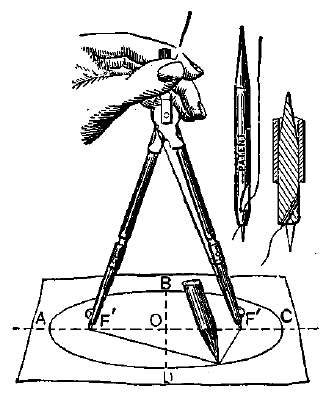 |
|
ELLIPSOGRAPHIC TURN TABLE—The table sits upon a trammel frame, which moves a bar with gimbal yoke and sliding rod to carry the pen or pencil, it makes an ellipse from a circle to a straight line. |
ELLIPSOGRAPH—A pair of dividers with points perforated like the eye of a needle allows of adjusting the length of the thread to any size curve and holding the end under the thumb on the head of the dividers. The points with their eyes are shown at the right-hand side. |
OMNI-TELEMETER—For obtaining the distance of an object by two observations on a line at right angles. A, direct line of sight through the half silvered mirror D; X, reflected line of sight at 90° or variable by the mirrors D, F. The lever L varies the angle of the mirror, F, by means of the micrometer screw C, and graduated disk G. E, adjusting screw for the mirror D. |
Parabola Scriber—
Geared EllipsographHyperbola Scriber—
Pantograph—
Lazy-Tongs Pantograph—
Perspective Centrolinead—
Spherometer —
SECTION 18: MISCELLANEOUS DEVICES.
ANIMAL POWER, SHEEP SHEARS, MOVEMENTS AND DEVICES, ELEVATORS, CRANES, SEWING, TYPEWRITING, AND PRINTING MACHINES, RAILWAY DEVICES, TRUCKS, BRAKES, TURNTABLES, LOCOMOTIVES, GAS, GAS FURNACES, ACETYLENE GENERATORS, GASOLINE MANTLE LAMP, FIREARMS.
Human Treadmill—
Horse-Power Tread Wheel—
Horse-Power Machine—
Dog Power Machine—
Geared Horse-Power—
Multiple Bladed Sheep Shears—
Horse Clipper—
Machine Sheep Shears—
"Almond's" Flexible Metallic Tube—
Evolution of a Wood Screw—
Artificial Leg and Foot—
Mean Time Sun Dial—
Door Push Check—
Folding Ladder Simple Combination Lock—
Tripod—
Double Spherical Socket—
Disc Slicer—
Micrometer Screw Adjustment—
Correct Principle in Setting a Hot-Water House Boiler—
Under-Feed Heating Furnace—
Harvester or Mowing Machine—
Bell Clapper Movement—
Piano Key and, Action—
Lapidary or Lithologicai Lathe—
Wire-Drawing Machine—
Wire-Covering Machine—
Stirring Machine for Grain Mash—
Sector Wheel Baling Press—
Wood Compression Carving Machine—
Belt-Driven Elevator—
Safety Catch for Elevators—
Elevator Safety Gear—
Swing Derrick—
Package Elevator—
Post Crane—
Wharf Crane—
Automatic Balance Crane—
Sewing-Machine Shuttle—
Sewing-Machine Feed Bar—
Sewing-Machine Hook and Bobbin—
Hook of the " Wheeler and Wilson " Sewing-Machine—
Sewing-Machine—
Spring Motor for Sewing-Machine—
Tinplate Lacquering Machine—
Single Cylinder Printing Press—
Typewriting Machine—
"Gordon" Printing Press—
Rack and Pawl‑Ball-Bearing Screw Jack—
Hydraulic Transfer Jack—
Rail-Cutting Saw—
Prouty Noble Automatic or Self-Winding Brake—
Street-Car Sand Box—
Friction brake for Street Railway Cars—
Car Truck for Street Railways—
Street-Car track—
Car Truck—
Trolley-Car Truck—
Freight-Car Truck—
Cable Railway Grip—
Cable Grip for Street Railways—
Linked Hinges—
Endless Cable Grip Car—
Street Railway Sweeping Car—
Equalizing Lever—
Novel Car Brake—
Wooden Frame Turn-Table—
Iron Frame Turn-Table—
Single-Cylinder Locomotive—
Modern Locomotive and Tender—
Passenger Locomotive, Eight-Wheel Model—
Ten-Wheel Freight Locomotive—
Freight Locomotive—
Centre Valve for a Gas House—
Disc Valve for Large Gas Pipes—
Centre Guide Gas Holder—
Counter-Weighted Gas Holder—
Expanding Pipe Stopper—
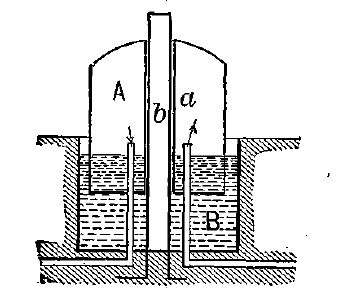 |
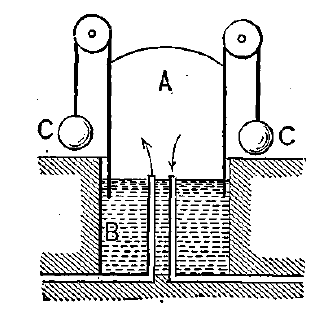 |
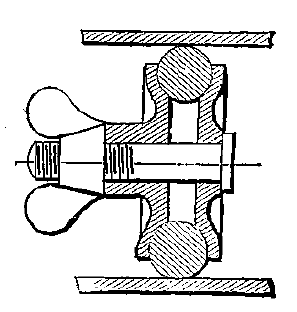 |
CENTRE GUIDE GAS HOLDER—A, the holder. b, centre guide. a, tube sliding on centre guide. B, tank. |
A, the holder. B, the water seal. C, the counter weights. |
|
Lantern Bellows Dry Gas Meter—
Wet Gas Meter—
Dry Gas Meter—
Gas Pressure Regulator—
Fuel Gas Burner—
Gas Furnace—
Gas-Heated Incubator—
Acetylene Gas Generator—
Automatic Gasoline and Mantle Lamp—
Acetylene Generator and Gas Holder—
Acetylene Burner—
Bayonet Joint—
Gun Lock—
Colt Cylinder Revolving Device for Firearms—
Magazine Rifle, "Lee-Metford" Model—
"Martini-Henry" Rifle—
Chassepot Gun—
Remington Rifle—
"Remington" Magazine Gun—
"Hotchkiss" Magazine Gun—
"Lebel" Rifle "Mauser" Rifle—
"Winchester" Magazine Rifle—
Disappearing Gun, "Moncrief Model"—
SECTION 19: STRAIGHT LINE MOVEMENTS.
IN THE DESIGN OF MECHANISMS OF MANY KINDS IT IS OFTEN NECESSARY THAT SOME POINT OR PART OF THE MACHINE MOVES IN A STRAIGHT LINE SO THAT FOR A CERTAIN DISTANCE THE MOVEMENT OF SUCH PARTS WILL ALWAYS BE MAINTAINED ALONG A PREDETERMINED PATH. SUCH MOVEMENTS ARE USED IN OIL SWITCHES, AUTOMATIC AND SPECIAL MACHINERY.
Two Lever and One Link Straight Line Motion—
Two Lever and Three Link Straight Line Motion—
Two Lever and One Link Straight Line Motion—
One Lever and Sliding Link Straight Line Motion—
One Lever and Two Link Straight Line Motion—
Three Lever Two Link Straight Line Motion—
Two Lever, One Link Straight Line Motion—
Three Lever, Two Link Straight Line Motion in Opposite Directions—
Two Link, One Lever. Straight Line Motion—
Oil Switch Movement with Three Levers and Two Links—
Oil Switch Movement with Two Levers and One Link—
Oil Switch Movement with Two, Levers and One Link—
Oil Switch Movement with Two Levers and One Link—
Oil Switch Movement with Three Levers and Three Links—
INDEX.
MECHANICAL MOVEMENTS POWERS AND DEVICES
Mechanical Movements is a great work of reference for inventors and experimenters, mechanical students, artisans and any workingman with an inquiring mind and the ambition of an engineer. For anyone with a real interest in mechanical thought and work, this book will fully explain mechanical movements, devices used in constructive and operative machinery and the Mechanical Arts. Mechanical Movements will be your valued mechanical dictionary, commencing with a rudimentary description of the early known mechanical powers and detailing the various motions, appliances and inventions used in the mechanical arts through to present times.

